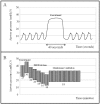Current Concepts of ARDS: A Narrative Review
- PMID: 28036088
- PMCID: PMC5297699
- DOI: 10.3390/ijms18010064
Current Concepts of ARDS: A Narrative Review
Abstract
Acute respiratory distress syndrome (ARDS) is characterized by the acute onset of pulmonary edema of non-cardiogenic origin, along with bilateral pulmonary infiltrates and reduction in respiratory system compliance. The hallmark of the syndrome is refractory hypoxemia. Despite its first description dates back in the late 1970s, a new definition has recently been proposed. However, the definition remains based on clinical characteristic. In the present review, the diagnostic workup and the pathophysiology of the syndrome will be presented. Therapeutic approaches to ARDS, including lung protective ventilation, prone positioning, neuromuscular blockade, inhaled vasodilators, corticosteroids and recruitment manoeuvres will be reviewed. We will underline how a holistic framework of respiratory and hemodynamic support should be provided to patients with ARDS, aiming to ensure adequate gas exchange by promoting lung recruitment while minimizing the risk of ventilator-induced lung injury. To do so, lung recruitability should be considered, as well as the avoidance of lung overstress by monitoring transpulmonary pressure or airway driving pressure. In the most severe cases, neuromuscular blockade, prone positioning, and extra-corporeal life support (alone or in combination) should be taken into account.
Keywords: acute respiratory distress syndrome; critically ill patients; lung-protective ventilation; positive end-expiratory pressure.
Conflict of interest statement
The authors declare no conflict of interest.
Figures





References
-
- Bernard G.R., Artigas A., Brigham K.L., Carlet J., Falke K., Hudson L., Lamy M., Legall J.R., Morris A., Spragg R. The american-european consensus conference on ards. Definitions, mechanisms, relevant outcomes, and clinical trial coordination. Am. J. Respir. Crit. Care Med. 1994;149:818–824. doi: 10.1164/ajrccm.149.3.7509706. - DOI - PubMed
-
- Ranieri V.M., Rubenfeld G.D., Thompson B.T., Ferguson N.D., Caldwell E., Fan E., Camporota L., Slutsky A.S. Acute respiratory distress syndrome: The berlin definition. JAMA. 2012;307:2526–2533. - PubMed
-
- Esteban A., Ferguson N.D., Meade M.O., Frutos-Vivar F., Apezteguia C., Brochard L., Raymondos K., Nin N., Hurtado J., Tomicic V., et al. Evolution of mechanical ventilation in response to clinical research. Am. J. Respir. Crit. Care Med. 2008;177:170–177. doi: 10.1164/rccm.200706-893OC. - DOI - PubMed
Publication types
MeSH terms
LinkOut - more resources
Full Text Sources
Other Literature Sources
Medical

